Key takeaways:
- Crowdfunding builds a supportive community, validating authors’ projects and generating pre-launch marketing buzz.
- Engaging with potential readers before and during the campaign enhances their investment and interest in the project.
- Choosing the right crowdfunding platform and crafting a compelling pitch are critical for campaign success.
- Transparency, flexibility, and celebrating small wins foster deeper connections with backers and maintain momentum.
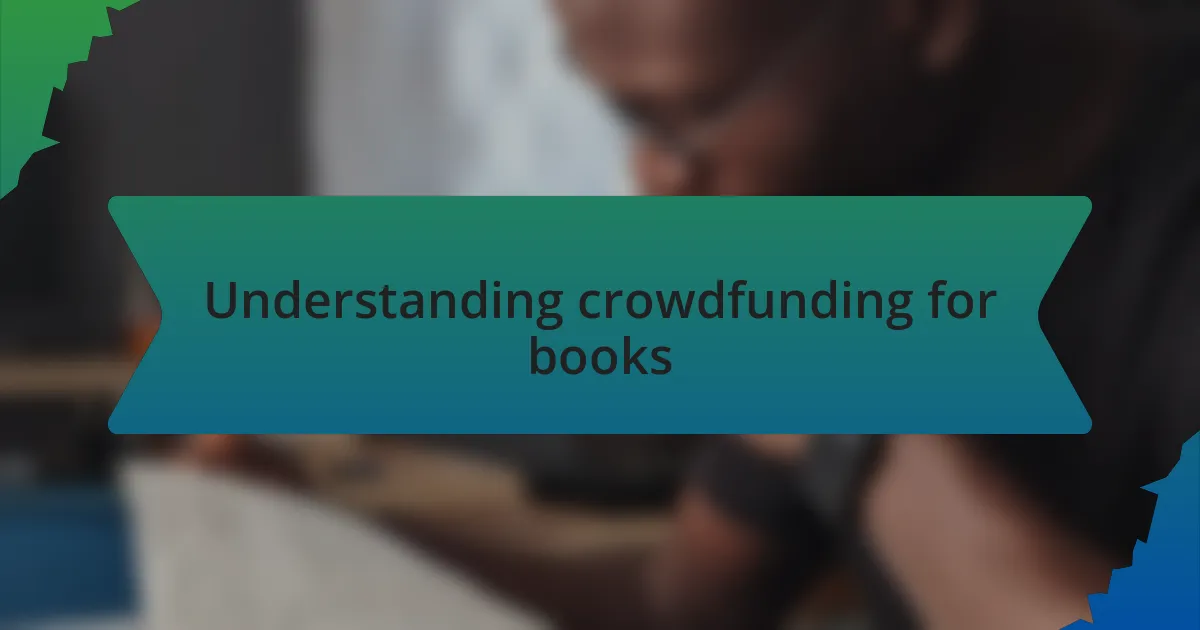
Understanding crowdfunding for books
Crowdfunding for books can feel like stepping into uncharted territory, especially for first-time authors. I remember launching my own campaign and feeling a mix of excitement and anxiety. Would people resonate with my story? That uncertainty is something many writers face when they consider asking for support directly from their audience.
The beauty of crowdfunding lies in its ability to build a community around your work. I was pleasantly surprised to find that friends, family, and even strangers rallied behind my project, transforming my vision into a shared endeavor. It’s a profound reminder that people are often eager to invest in stories that resonate with them. Have you ever thought about who might support your journey?
As you explore this avenue, it’s crucial to understand the types of crowdfunding platforms available. Each has unique features and audiences, altering how successfully you can reach potential backers. For instance, using Kickstarter can connect you with creative people, while IndieGoGo offers flexibility. Reflecting on my experience, the choice of platform significantly impacted my campaign’s trajectory, shaping my interactions with potential readers.
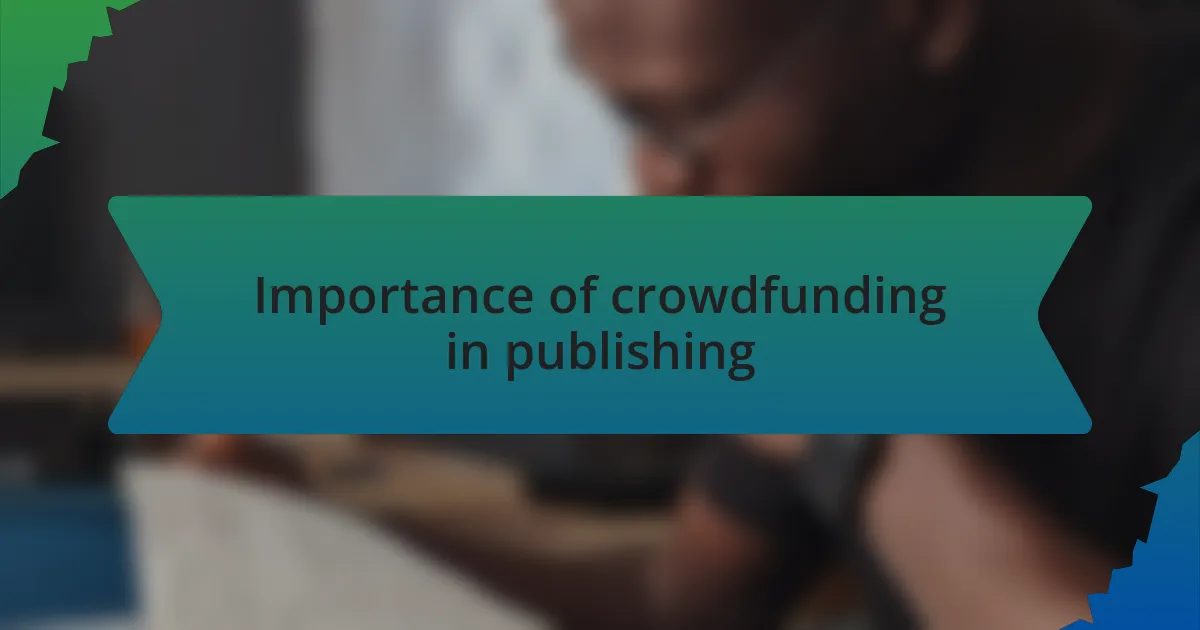
Importance of crowdfunding in publishing
The importance of crowdfunding in publishing cannot be overstated. When I launched my crowdfunding campaign, I realized it was not just about securing funds; it was about validating my project. This support from backers felt like a vote of confidence, reminding me that there are individuals out there who believe in my storytelling as much as I do.
Additionally, crowdfunding serves as a marketing tool, generating buzz before the book even hits the shelves. I vividly recall the surge of excitement I experienced each time a new backer pledged support, as if each contribution were a cheer echoing my creative aspirations. Have you ever felt that thrill of shared enthusiasm? It’s a unique energy that I found invaluable in building momentum for my book.
Moreover, the engagement with potential readers during the crowdfunding process fosters a solid foundation for future interactions. Sharing updates and communicating directly with supporters turned them into a community invested in my success. This ongoing relationship provided invaluable feedback and insights that shaped not only my book but also my growth as an author. Isn’t it fascinating how a funding initiative can transform into a nurturing ecosystem for creativity?
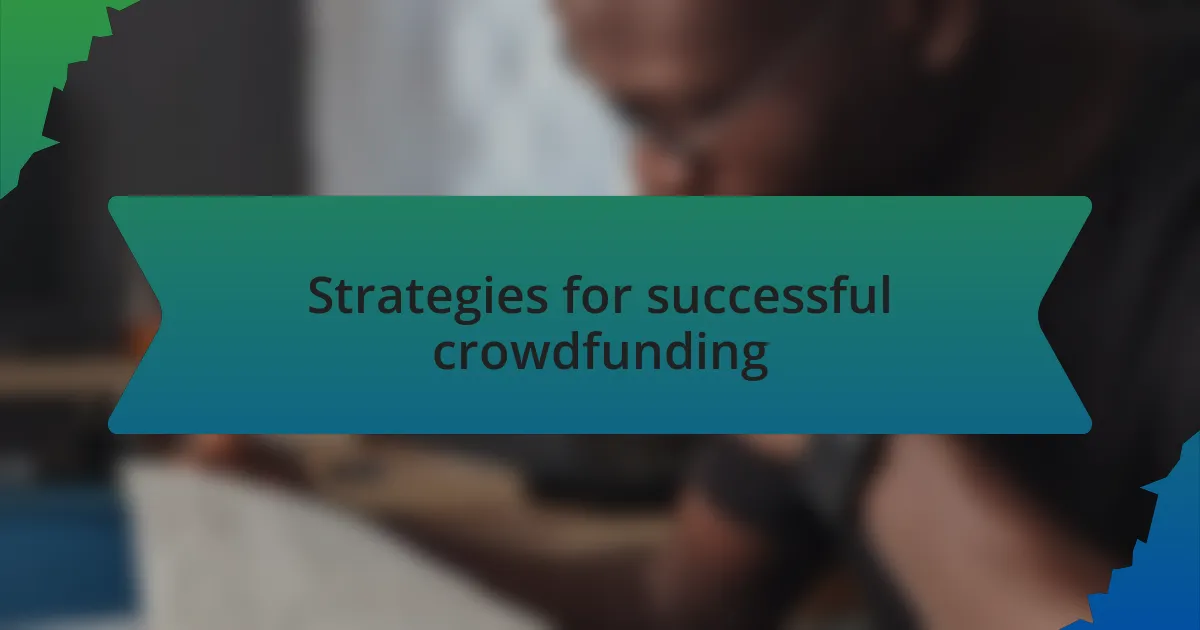
Strategies for successful crowdfunding
One effective strategy for successful crowdfunding is to build a strong pre-launch community. Before I even set my campaign live, I engaged with potential readers through social media and newsletters, sharing snippets of my work and behind-the-scenes updates. It wasn’t just about gathering pledges; these interactions transformed my audience into enthusiastic supporters, eager to see my project come to life. Have you ever wondered how much a community can amplify your efforts?
Another crucial aspect is offering compelling rewards. I learned that it’s essential to create incentives that resonate with backers, which can range from digital copies of my book to personalized thank-yous. When I offered a unique reward, like a one-on-one virtual chat, the response was incredible. Many backers felt a personal connection, and I realized that by sharing parts of my journey, I was not just giving away a product; I was inviting them into my world.
Finally, consistent communication throughout the campaign made a significant difference. I remember feeling the pressure as the deadline loomed; keeping my backers updated with progress and challenges helped maintain their excitement. Sharing my triumphs and setbacks—like hitting certain funding milestones or tweaking my goals—created a sense of shared investment. It challenged me to stay accountable while fostering a closer bond with my backers. Isn’t that connection what independent publishing is all about?
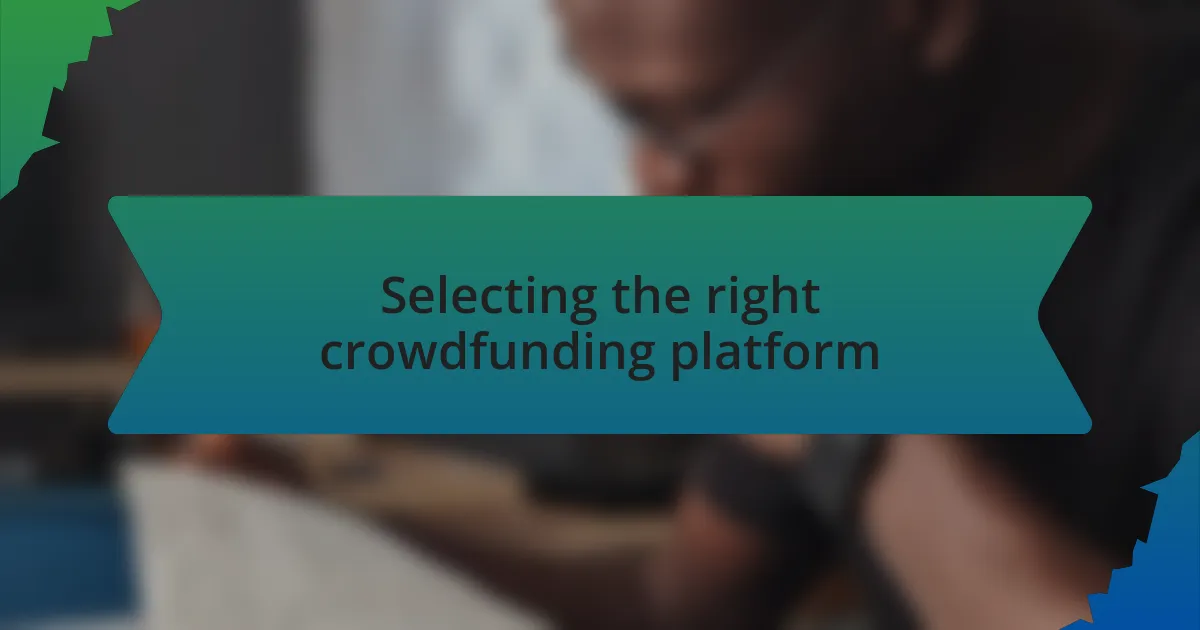
Selecting the right crowdfunding platform
Choosing the right crowdfunding platform can feel overwhelming, given the variety of options available. I remember when I was in that stage; I spent hours comparing websites, such as Kickstarter and Indiegogo. Each platform has its own fee structures, audience reach, and rules. Have you considered what specific features might benefit your project the most?
For me, the user interface and community engagement of the platform played crucial roles. I chose a site that not only had a straightforward setup process but also fostered interaction among backers and creators. It was eye-opening to see how an active community could provide encouragement and support; it felt like I was part of a larger family devoted to literature.
Another factor that weighed heavily on my decision was the success rate and track record of the platforms with books similar to mine. It felt reassuring to see other authors achieve their goals and to know that their success could be replicated. So, reflect on where your book fits within the crowdfunding landscape; choosing the right platform can make all the difference in bringing your vision to life.
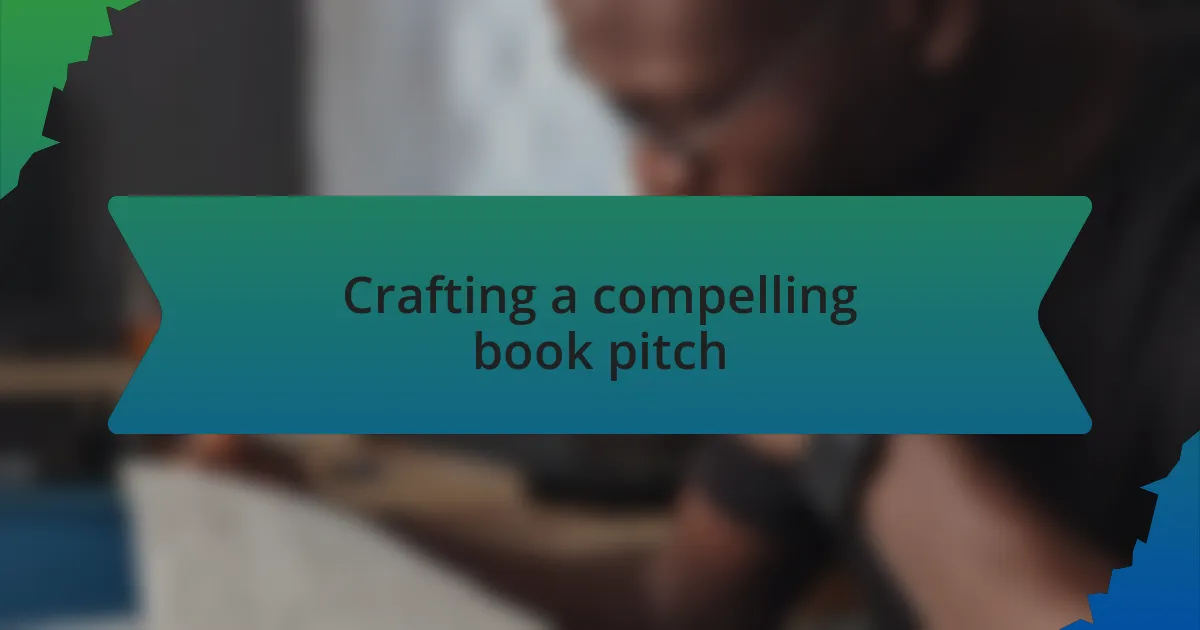
Crafting a compelling book pitch
When I started crafting my book pitch, I realized that it was like writing a mini-synopsis infused with my passion. I dug deep to find what truly set my story apart, knowing that potential backers would need to feel the energy and urgency behind my project. What if I shared the heart of my journey, the struggle that inspired my words? This personal touch not only captures interest but also creates a connection.
One technique that worked for me was incorporating a compelling hook right at the beginning. For example, I opened with a question that sparked curiosity: “What if you could rewrite your destiny?” This approach invites readers into a dialogue and makes them think critically about the themes in my book. I’ve found that when you start with a powerful question, it compels people to look deeper, wanting to understand the answers your book has to offer.
As I progressed, I learned the importance of being concise. All the passion and creativity in the world won’t resonate if your pitch is too lengthy. I aimed to convey the essence of my book in just a few sentences, painting a vivid picture without overwhelming my audience. By refining my message over and over, I noticed how clarity transformed my pitch from a simple description into an inviting call to action. How has brevity shaped your own writing challenges?
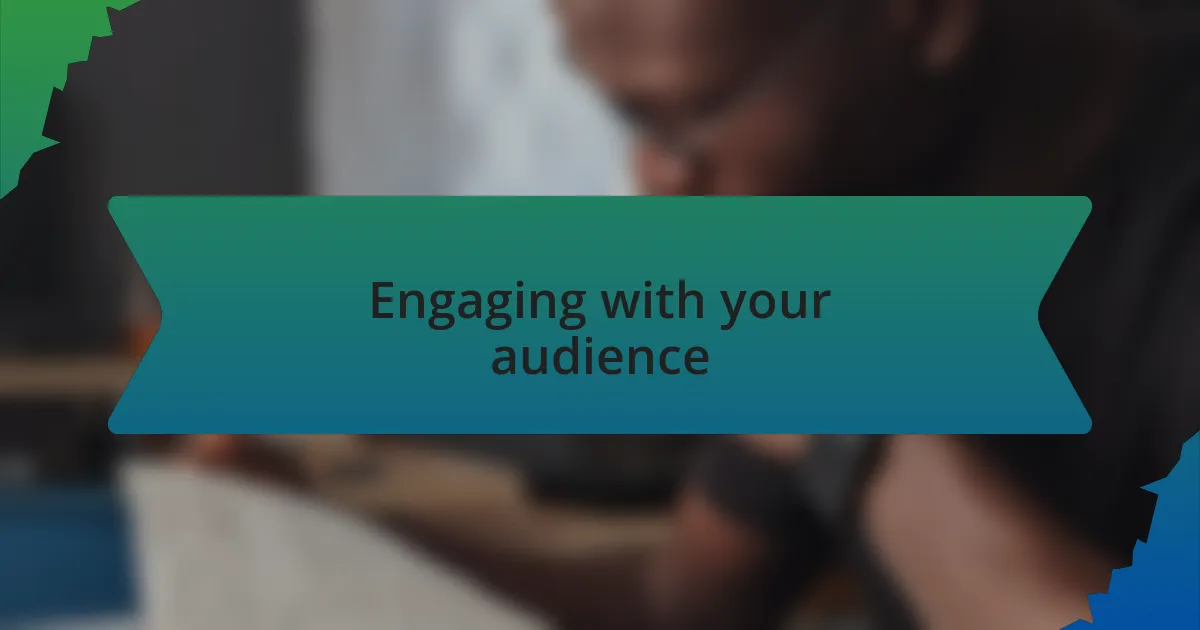
Engaging with your audience
Engaging with your audience became a pivotal part of my crowdfunding journey. I reached out through social media, sharing behind-the-scenes glimpses of my writing process. One post, where I spoke candidly about my late-night brainstorming sessions, generated a flood of comments from fellow writers who could relate. It struck me how vulnerability fosters connection; people want to see the real you, not just the polished final product.
I also found that creating polls and asking direct questions about specific story elements sparked lively discussions. At one point, I asked my followers to vote on character names, and the enthusiasm was palpable. It wasn’t just about gathering opinions; it deepened their investment in my project. Have you ever experienced that shift when your audience feels they have a stake in your creative choices? It’s exhilarating.
Moreover, hosting live Q&A sessions allowed me to connect in real-time. I remember one session where a reader shared how a theme in my story echoed their own life experience. Hearing that perspective was incredibly validating and reminded me of why I began this journey. Engaging in such ways can transform your audience from passive observers into enthusiastic supporters who feel personally connected to your book.
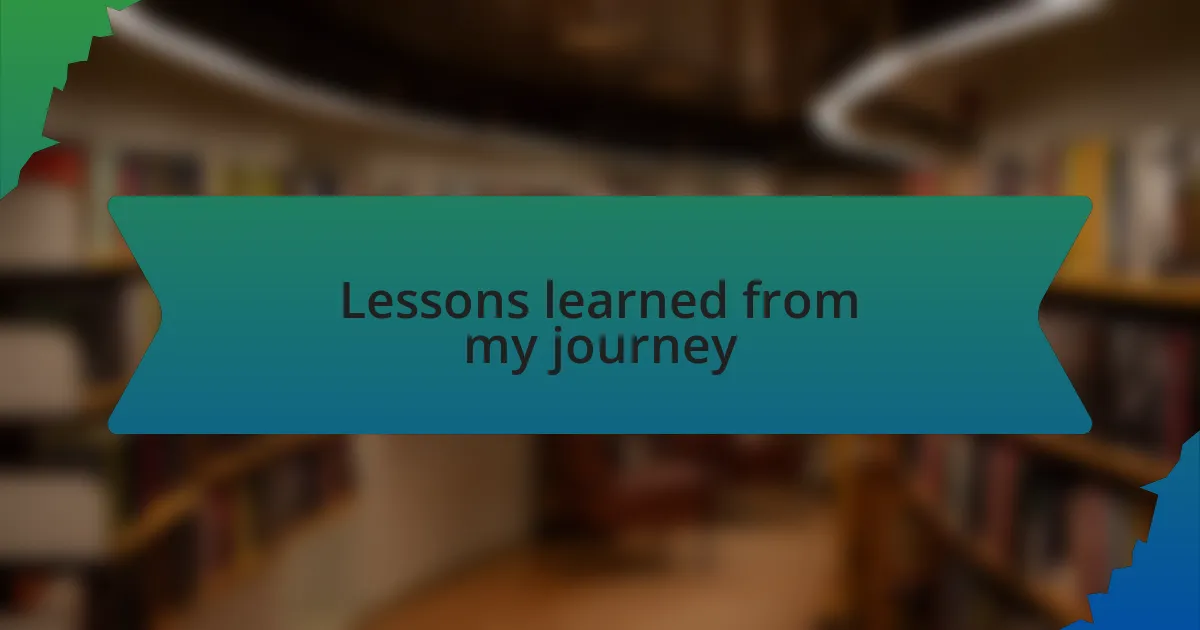
Lessons learned from my journey
Throughout my crowdfunding journey, one of the most significant lessons was the importance of transparency. I remember a moment when I revealed my funding goals and the challenges I faced in meeting them. The honesty in my updates not only garnered sympathy but actively encouraged support. Have you ever felt that relief when you shared your struggles, and people rallied around you? It’s a powerful reminder that authenticity can drive deeper connections.
I also learned that flexibility is crucial. There were times when I had to pivot my campaign strategy based on feedback I received. For instance, when my initial video pitch fell flat, I quickly shifted to a more heartfelt approach, sharing my personal story directly. This taught me that listening to my audience can turn obstacles into opportunities for greater resonance. Have you ever adapted your plans in a way that opened new doors? It can be surprisingly rewarding.
Lastly, I discovered that celebrating small wins along the way kept my momentum alive. Every time I hit a milestone, whether it was reaching a funding target or receiving positive feedback, I took the time to acknowledge it with my supporters. This not only boosted my morale but fostered a sense of community. It made me realize: when you share your triumphs and setbacks, your audience feels like they’re part of this journey, too. Isn’t that what we all crave—to belong to something bigger?